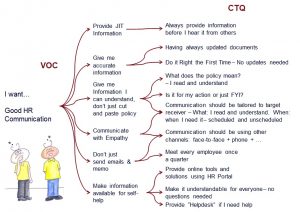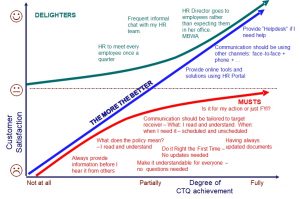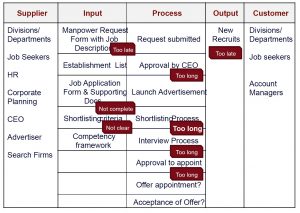Given today’s need for HR professionals to be strategic business partners, to be a ‘Voice of Conscience’ to the CEO as well as champion for the employees. Those with background in proven management methodologies and tools have a great advantage. HR Professionals who can present their business case for HR strategies and interventions with a compelling return on investment, supported by rock-solid data, will be well respected and regarded.
Understanding and using HR data analytics including basic statistics to convey messages goes a long way. Making proper use of HR data may help to identify drivers for staff satisfaction, staff turnover or staff engagement.
However, HR data analytics needs to have proper links to the business. Metrics used for the analytics have to be vital to the organisation. Rather than wasting money and time to collect data for the trivial many, the HR data analytics should link to the vital few.
Contributing to HR Data Analytics – Metrics Design
It is important to distinguish which metrics are truly adding value to the organisation. Few HR professionals have confidence that their measurement systems provide line managers with the information they need to make critical workforce decisions. Often their metrics do not even link to the corporate strategy and are unsuitable for contributing to improvement in overall business performance. Measuring for measurement’s sake is a time consuming waste.

Figure 1 – Translating VOC to CTQ
To determine which metric should be part of HR data analytics it is imperative to understand strategic initiatives as well as the organisation’s needs. There are simple yet valuable tools to help translating the needs of your organisation into metrics. This is the basis for identifying and closing gaps hence contributing to business results.
Voice of the Customer (VOC, Figure 1) is a structured multi-step process focusing on capturing the voices of HR’s customers – leaders and staff of your organisation – and translating it into CTQs (Critical to Quality), metrics and actions.
Prioritising Metrics for Data Analytics
Kano Diagram (Figure 2) is a simple yet powerful tool used to prioritise Customer Needs. Firstly, Musts are expected by your internal customers. By not delivering on Musts, dissatisfaction is inevitable. Hence, there is no need for reinforcements on them. Secondly, The-More-The-Better are satisfiers. More providence on these will contribute to satisfaction. Any form of deficiency will definitely create dissatisfaction. Thirdly, Delighters are representatives of a special set of requirements that can contribute vastly to satisfaction if received and diminutive disappointment if they are not present. They are difficult to detain since the customers usually don’t even think of them due to the minimal expectancy from them.

Figure 2: Kano Diagram for Prioritisation of CTQs
VOC and Kano are just an extension of what many organisations do anyway: capturing the employee satisfaction. Unfortunately, not everybody plays by the rules. In other words, they rather draw conclusions on high-level data without going to the root causes. The result is often not sustainable.
Benchmarking is a field that numerous HR professionals recognise. Benchmarking involves the process of comparing operations/departments within an organisation to each other or with other organisations. Metrics drawn from CTQs can assist benchmarking an organisation regarding their internal customer satisfaction.
Understanding the Drivers
Another tool is Process Mapping (SIPOC, Value-Added Analysis). SIPOC maps Suppliers, Inputs, Process Steps, Outputs and Customers of any given process. This can be a core business process or an HR process. The benefit of a SIPOC is in the high-level understanding of the process and its metrics that drive CTQ metrics. Figure 3 illustrates the effect of a recruitment process. It flags out potential reasons for long turnaround time.

Figure 3: SIPOC for Recruitment Process
After studying the processing time of each of the steps, it became obvious that “Shortlisting” consumed a considerable portion of the processing time. Why?
Digging into the details of this process the team found that one of their HR officers performed batching. She kept all the recruitment files until end of the week and tried to complete them on each Friday. If the workload was too much, she kept the remaining of the files until the following Friday…
Such findings are everywhere waiting for you to find. They are easy to embark upon and to resolve once the root cause is clear. However, resolving the issue is only part of the task. The other – sometimes even more important – part of the task is to promote innovative solutions and to encourage cross-departmental learning, managing the change.
Conclusion
For Lean Six Sigma professionals, all this is not new. They are trained in all the above-mentioned tools, and they are able to use them wisely. Today, we put more emphasis on using data for decision making. Why not consider having HR professionals with Lean Six Sigma skills? Just sending our HR staff to HR data analytics training without giving them the rest of the tools is like buying a data plan for the hand phone without a handset that can really make use of it.
HR professionals with knowledge of data analytics can deliver better service to their customers – their leaders and colleagues. Identifying requirements and gaps, analysing, improving and innovating processes as well as measuring the performance long-term to sustain the gains applies to all business processes, including HR.
HR Professionals with Lean Six Sigma knowledge are an added advantage for any organisation embarking on achieving a strategic HR role.

